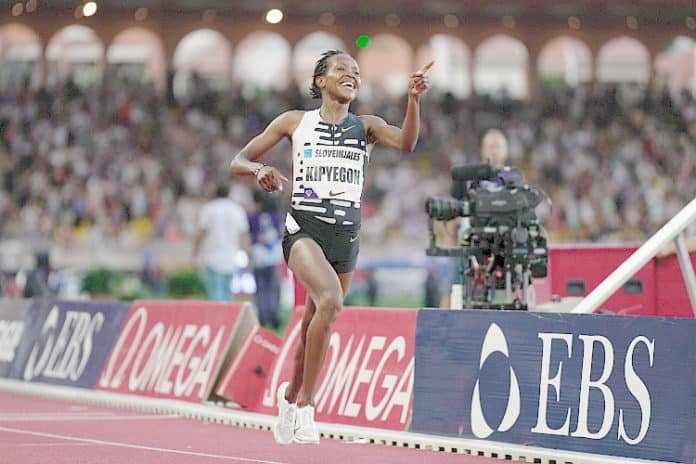★ The Sports Examiner: Chronicling the key competitive, economic and political forces shaping elite sport and the Olympic Movement.★
★ To get the daily Sports Examiner Recap by e-mail: sign up here! ★
≡ WHAT DID SHE ACTUALLY RUN? ≡
Nike’s “Breaking4” spectacle on Friday at the Stade Charlety in Paris was set up as a long-shot try at a women’s four-minute mile by the brilliant Faith Kipyegon, not only the triple Olympic champion in the women’s 1,500 m, but also the world-record holder in the 1,500 m (3:49.04), mile (4:07.64) and formerly at 5,000 m (14:05.20).
Her chances of getting close to four minutes were poor to start, as reported in The Sports Examiner in July 2023, after she set the mile mark at 4:07.64:
“Looking at the men’s 4-minute mile, it took 21 years to go from New Zealand’s Jack Lovelock and his 4:07.6 mark in 1933 to 1954 for Roger Bannister (GBR) to run 3:59.4.
“That period was impacted by World War II, but Swedes Gunder Hagg and Arne Andersson did lower the mile record from 4:06.4 in 1937 to 4:01.4 in 1945.”
That means a women’s sub-4 might come around 2040 with today’s better conditions, shoes, track and so on. Not in 2025.
But Nike put together a spectacle, as they had done for Kenyan marathon star Eliud Kipchoge and his sub-2:00 marathon tries in 2017 (2:00:25) and 2019 (1:59:40). And Kipyegon was game, with a special, wind-resistant suit and special shoes, clinging to 4:00 mile pace through the halfway mark, and close at three-quarters, then falling off.
French coach and statistician P.J. Vazel broke it down brilliantly on X:
Faith Kipyegon Splits (video timing, rounded *up* to the nearest tenth)
200m 30.1
400m 1:00.5
600m 1:30.5
800m 2:01.0
1000m 2:31.0
1200m 3:01.9
1500m 3:49.0Imperial distances
1/8M 30.3
1/4M 1:00.9
3/8M 1:31.2
1/2M 2:01.7
5/8M 2:31.9
3/4M 3:03.0
7/8M 3:34.4
1 Mile 4:06.91 pic.twitter.com/5hQyM9ZoDR— PJ Vazel (@pjvazel) June 27, 2025
At 60.9, 60.8 and 61.3, she was at 3:03.0 at the three-quarters mark, but could manage only 63.9 on the final lap for a final time of 4:06.91, as shown on the timing strip at the top of the screen.
¶
That’s where the controversy started, as moments later, a screen graphic showed her time as 4:06.42, almost half a second faster.
Multiple observers got their stopwatches out and re-timed the race – including Vazel, as accurate as they come – with the unanimous consensus that Kipyegon almost certainly ran 4:06.91 and not 4:06.42.
So what happened?
LetsRun.com inquired with Nike about the time difference, but has not indicated it received an answer.
There’s really no reason to change Kipyegon’s time as she ran the fastest mile in history by a woman – faster than her 4:07.64 world mark from 2023 – so the half-second change would not make a difference that way.
No one is saying, but it’s a switch that statisticians won’t soon forget.
¶
Even with the best-ever time, the mark is not eligible to be ratified as a world record, which everyone knew ahead of time. There are two rules which appear to be out of reach by the way the attempt was set up:
● World Athletics rule 31.1 on records states:
“A World Record shall be made in a bona fide competition which has been duly arranged, advertised and authorised before the day of the event by the Member in whose Country or Territory the event takes place and which has been conducted under and in compliance with the Rules.
“For individual events, at least three athletes and for relay events, at least two teams must be bona fide competitors in the event. Except for Field Events conducted as provided in Rule 9 of the Technical Rules and competitions held outside the stadium under Rules 54 and 55 of the Technical Rules, no performance set by an athlete will be ratified if it has been accomplished during a mixed competition.”
Kipyegon’s try failed on two points: there weren’t three “bona fide” competitors in the race, as British distance stars Jemma Reekie and Georgia Hunter-Bell – the other women in the field – were both announced as running two laps only and not trying to finish. Further, the cadre of 11 men’s pacers makes this a “mixed” competition and ineligible for record consideration.
● World Athletics’ regulations on shoes states that “Bespoke Shoes are not permitted to be worn in any Applicable Competition,” defined as:
“‘Bespoke Shoe’ means an Athletic Shoe that is one-off made to order (i.e. that are only one of its kind) specifically for a single Athlete and is not Available for Purchase.”
There was reporting that Kipyegon’s shoes were a prototype and not a one-off, in which case it would have had to be approved in advance by World Athletics as a “Development Shoe.” Which it was not.
So, there was no way Kipyegon’s mark – whatever it was – was going to be eligible to be a record of any kind.
¶
None of this should take away from a brilliant effort by Kipyegon, who did run a mile faster than any woman has before. And no other woman has ever run faster than 4:12.33!
Now, at 31, what will Kipyegon do with the rest of her season? Besides this mile event, she has run only once, a 2:29.21 win in the 1,000 m at the Xiamen Diamond League in China in late April. As 2023 World Champion in the 1,500 m and 5,000 m, she has a direct entry in September’s World Athletics Championships and she is obviously very, very fit.
More world records on the way, perhaps, in the Diamond League season? She’s listed to run in this Saturday’s Prefontaine Classic in the women’s 1,500 m!
¶
★ Receive our exclusive, weekday TSX Recap by e-mail by clicking here.
★ Sign up a friend to receive the TSX Recap by clicking here.
★ Please consider a donation here to keep this site going.
For our updated, 694-event International Sports Calendar for 2025 and beyond, by date and by sport, click here!























